How Easy is It to Tranfer Self Driving Car Technology to Semi Trucks
A Detailed Commercialization Analysis of Autonomous Vehicle Technology in the Trucking Industry
By: Michael Wishart, Joey Skavroneck, and Sven Beiker
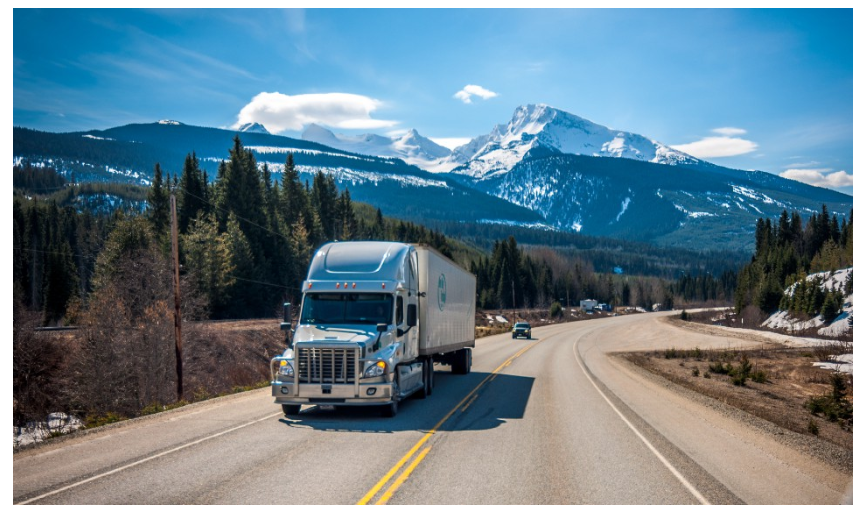
Overview of the United States trucking industry today
If you are reading this paper in the United States (US), nearly 70% of the physical objects around you were delivered on a truck. The trucking industry is the backbone for goods commerce in the US — transporting over $11 trillion dollars of goods each year.
In terms of gross revenue and employment, the trucking industry is massive. 2018 industry revenue approached $800B while over 3.5M people are employed as truck drivers.
Trucks come in all shapes and sizes with a wide array of capabilities, customers, operators, and manufacturers. The most common way to categorize trucks is by the maximum weight that the vehicles can transport (see Figure 1). Both federal and state government agencies designate different safety standards across these truck classes.
Class 8 trucks transport large volumes of goods and spend a considerable portion of their miles on the highway. Given Class 8 trucks' freight value and their simpler operating domains, they are the target for commercializing autonomous vehicle technology.
This paper will evaluate the go-to-market strategies of companies seeking to automate the long-haul trucking process via Class 8 trucks.
Market Landscape — Who are the players:
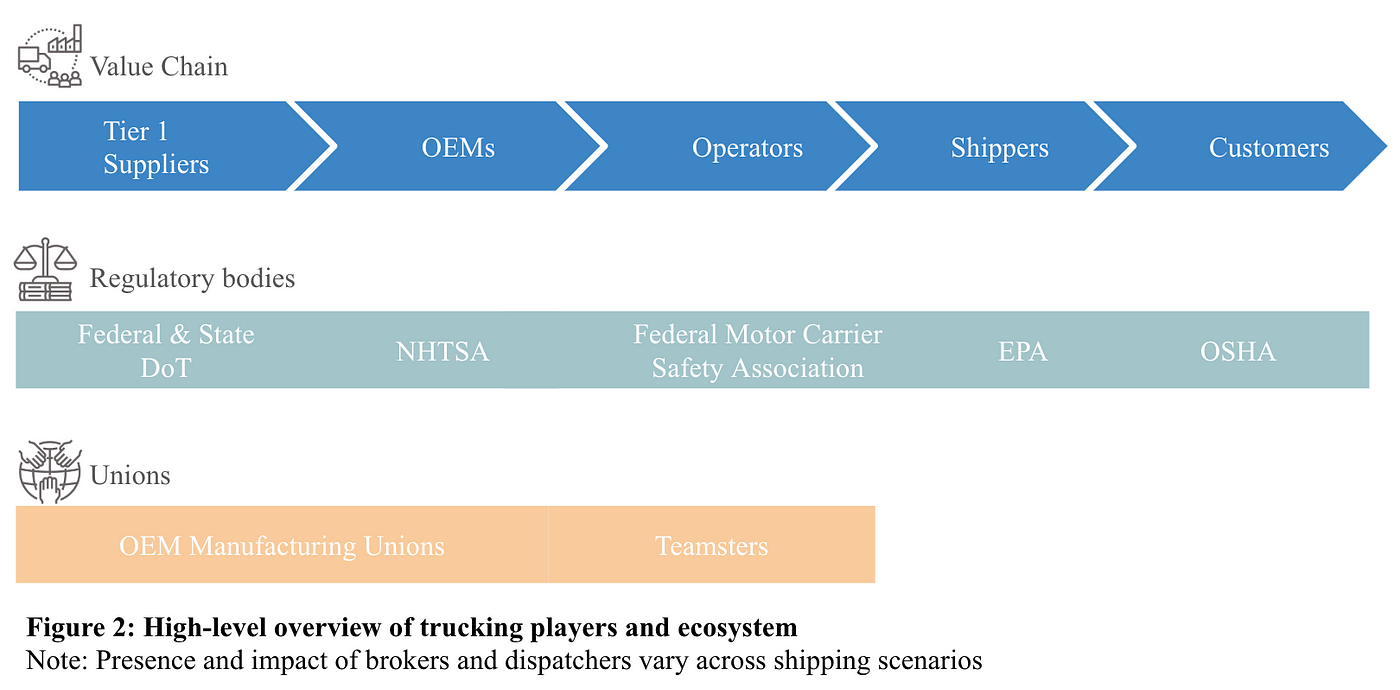
The Old Guard — Vehicle Manufacturers and their partners:
We will talk more about the Truck Vehicle OEMs later in this report, but it's worth mentioning that the US Class 8 manufacturing market is dominated by four major players: Daimler (Freightliner, Western Star), PACCAR (Kenworth, Peterbilt), International (Navistar), and Volvo (Mack). Together, these companies sold right under 250,000 Class 8 trucks in 2018.
Truck manufacturers are experiencing a booming period marked by June 2019 YoY double-digit sales growth (10.1%) and major order backlogs. The truck manufacturers are supported by a global network of suppliers. Volvo Group alone has 51,000 (Tier 1) suppliers delivering 2.5 billion parts to Volvo Truck plants annually. The continued growth in trucking will benefit Truck OEM suppliers as the "sharp increase in freight activity and lower fuel prices have paved the way for motor carriers to invest in new truck purchases."
Carriers (Operators):
Fleet operators source trucks from vehicle manufactures to transport freight. The three major types of fleet operators are:
- Courier and Parcel — Companies that transport mail and small goods (e.g., UPS, FedEx, USPS). The courier and parcel operator market is consolidated with most of the market share taken up by the top three providers.
- Private — Companies that transport their own goods (e.g., Walmart, Kroger). There are more than 700,000 private fleet operators registered with the Federal Motor Carrier Safety Administration (FMCA).
- For-hire — Companies that are paid to transport goods that they do not own (e.g., J.B. Hunt, Knight Transportation, Hub Group). The for-hire operator market is large and extremely fragmented. Over 890,000 for-hire carriers are registered with the FMCSA and over 90% of carriers operate six or fewer trucks.
Brokers and Dispatchers:
Within the for-hire trucking ecosystem, brokers and dispatchers are two players that provide critical coordination activities.
Brokers work with shippers to find fleet operators to carry their loads. The shipper first tells the broker what they will pay for freight. From there, the broker will post on a digital marketplace — or "load board" — to find an operator willing to take the load. Brokers make money off of the difference between what they are paid by the shipper and what they pay the carrier. Digital brokerage start-ups such as Uber Freight and Transfix are trying to disrupt the brokerage industry by removing the middle man. They hope to improve brokerage speed, transparency, and economics through automation.
Dispatchers represent carriers when engaging with brokers. Given that around 16.6% of trucking miles driven last year were empty — or "dead-head" — miles, the goal of dispatchers is to take bookings that improve a carrier's fleet utilization and profitability. Dispatchers are compensated by a commission on the booking revenue.
Regulators and Unions:
Regulation in the long-haul trucking industry is a complex process that involves agencies at the federal and state levels. The National Highway Traffic Safety Administration (NHTSA) and the EPA regulate the safety and environmental standards in Class 8 truck manufacturing. The operation of Class 8 trucks is regulated by the FMCSA, State DoTs, and OSHA to ensure that drivers are qualified, safe, and well-rested to drive.
One more stakeholder to keep in mind are the unions (i.e. the Teamsters Union — 1.4 million member union in the USA) which has seen its membership among truckers precipitously drop from 2 million members to 75 thousand since the 1970s. This is largely attributed to the Motor Carrier Act of 1980 which removed a lot of the regulations for the trucking industry. This resulted in
- Reduced barriers for trucking companies to form
- Removed the need to "purchase" trucking routes
- Increased price competition
As such, an increasing number of trucking companies were able to hire non-union truckers, and subsequently charge a lower price. This led to layoff rates among Teamster truckers to the tune of 29% to 36% as trucking companies with union drivers weren't able to compete.
After speaking with an individual from a local delivery carrier and reviewing a variety of truck driver publications, we believe that it will continue to be difficult for truck drivers to unionize given that any wage increase for drivers will incentivize carriers to increase rates in order to maintain their operating models. As a result, wage increases will arguably only benefit drivers while hindering the freight economy as wage increases are transferred to consumers.
We believe that the outcome of the 1980 Motor Carrier Act will foreshadow the non-market dynamics of autonomous trucks. As automated trucks provide a more affordable method of transportation, trucking companies that aren't able to innovate may face the same fate as trucking companies with union drivers in the 80's.
Key Trends Facing the Industry
The most impactful trends facing the trucking industry today can be categorized into three main areas:
- Demand — e-commerce activity in the United States is at an all time high. US retail e-commerce sales reached $315B in 2018 and is expected to reach $565B by 2023. The trucking industry will continue to grow as more consumers rely on shipping to retrieve their purchased goods. Increased freight demands — along with rapidly growing consumer expectations for expedient delivery — will push the trucking industry to find ways to innovate and expand.
- Supply — Although the freight market has been growing, driver shortages have become a major issue across the industry. The American Trucking Associations estimate that the driver shortage has reached around 60,000 and is expected to grow. Additionally, the quality of life for truckers in the long haul trucking space is arguably very challenging as suicide rates are among the top five professions in the country.
- Technology — Electrification and automation are the two technology trends that are garnering the most investment in the trucking space — and notably so. According to the American Transportation Research Institute, fuel and driver costs make up 24% and 43% of motor carrier costs respectively. Both fuel costs and driver costs have been increasing due to higher fuel prices and the wage raises required to attract additional drivers.
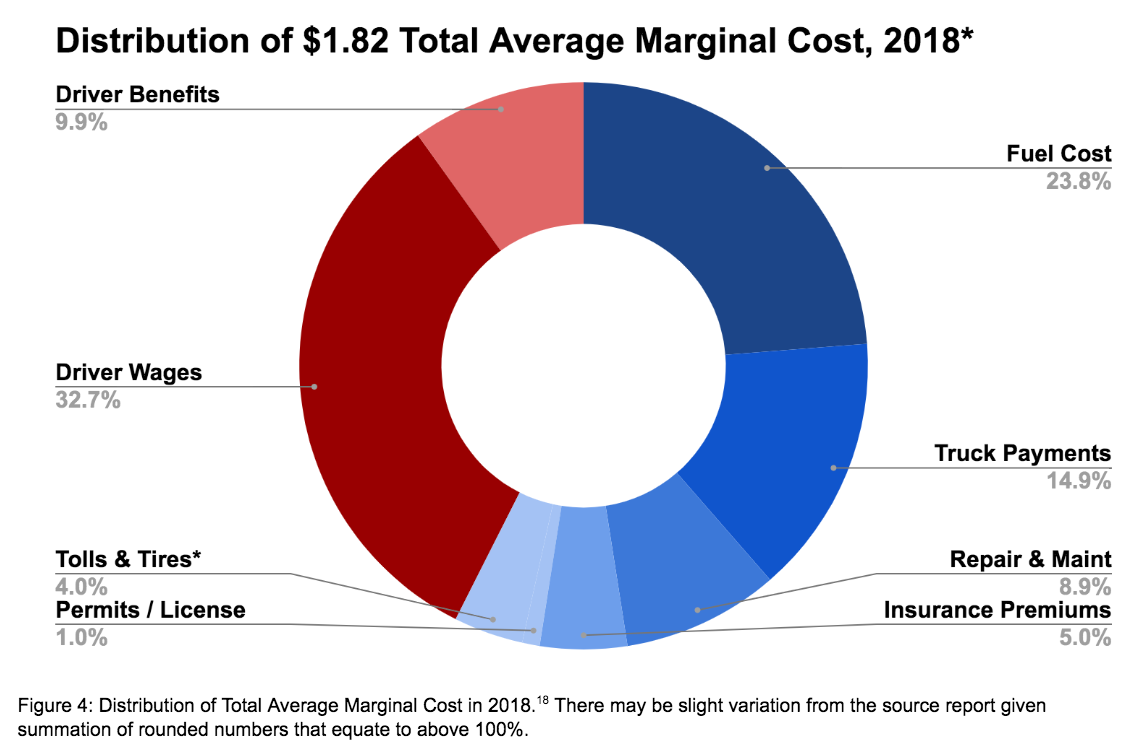
The challenges associated with low utilization rates, driver shortages and constraints (both physical and regulatory), and fuel efficiencies leave the trucking industry ill-equipped to meet the needs of an increasingly digital economy. Additionally, driver costs (wages and benefits) have increased as a percentage of average marginal cost from 39% in 2010 to 43% in 2018. As such, existing players — as well as new entrants — are looking to provide new solutions through automated technology to meet these needs. Automation will enable trucking operators to solve everyday challenges by increasing fleet utilization, augmenting driver capabilities, and improving fuel economies. For example, an autonomous vehicle supplier explained how automated trucks will realize greater fuel efficiency as a result of maintaining fuel efficient speeds of 62 MPH and better understanding the grades of the road for acceleration. In turn, we will see continued growth of a Trucking-As-A-Service industry that may drastically change how goods are transported from point A to B.
The Challengers: Market Landscape for the New Self-Driving Trucks
"We wanted flying cars, instead we got 140 characters." — Peter Thiel
The public's disappointment with technology delays may be subsided in the coming years due to advancements with self-driving technology. Given that over $33.8B dollars has been invested in the autonomous driving industry by venture capitals since 2010, more technological advances can be expected to come. Seven of the top technology companies ($298M TuSimple, $200M Plus.AI, $117 Embark, $78M Peloton, $52M Ike, $40M Kodiak, $20M Starsky Robotics) focused on developing self-driving capabilities for the trucking industry have received an average of over $100M in funding per Crunchbase.
Through our 20+ interviews, we've come to appreciate the wide range of benefits that automated technology can provide to the trucking industry. We were, however, most surprised through our discussions by the fact that only two out of eight interviewees have considered lower costs associated with the driver to be the major value add that automated driving technology can provide. This is largely due to skepticism that the technology will be able to reduce the driver in all use cases as the driver's job is not limited to driving (i.e. security, unloading/loading, relationship management, etc).
Nevertheless, there are companies that are looking to automate portions of trip in certain "operational design domains" or ODD. An ODD is the specific operating domain(s) in which an automated function or system is designed to properly operate, including but not limited to geographic area, roadway type, speed range, environmental conditions (e.g., weather, daytime/nighttime), and other domain constraints. Under certain ODDs, technology companies believe they can leverage technology to remove the driver, which accounts for close to a third of the cost for a trucking business, as a way to realize economic benefits with automated technology. Beyond reducing the cost of the driver, additional economic (and societal) benefits can be achieved with self-driving technology through:
- Improved fuel economies
- Increased utilization
- Reduced accidents
Market Landscape for the New Self-Driving Trucks — Technological Challenges
In order for self-driving trucks to become a viable solution, the industry will need to overcome hurdles with developing a reliable technology stack. As timelines for the rollout of self driving technology becomes more ambiguous in ride-sharing applications, there is more focus in leveraging existing technology for trucking where the operational design domain has less variability. However, much work still needs to be done as discussions with two premier suppliers for automated trucks highlighted that only "30% — 40% of autonomous vehicle (AV) technology translates between cars and trucks."
The areas that do not translate from driving a car to trucking involve:
- Truck motion control and driving functions — truck drivers are better than car drivers at managing the effect of high winds (e.g., 45 MPH) on the truck's trailer.
- Shock profiles — the area close to the cabin is built for comfort, but the chastity or lower areas of the vehicle will expose sensors to significant levels of vibration.
- Truck shape and size — sensors can only be placed on the truck trailer since shipping containers will be interchanged across different modes of transport. Additionally, the added dimensions and weight of a truck require further calibration of the AV technology.
As we evaluate the technology stack, we've broken down the actions performed by autonomous technology along with the associated hardware components into three major areas: Perception, Decision, Actuation.
Perception: Perception is composed of radars, cameras, lidars, ultrasonic, etc. As a human driver, your decisions are based on what you see. As such, you need these complementary sets of devices to provide the vehicle with an all encompassing view of its environment.
Decision: As can be inferred from the title, the Decision phase involves the vehicle leveraging algorithms and hardware to capture data, manage data, store the data, and perform compute functions so that the vehicle can understand the right course of action.
The decision phase is arguable the biggest hurdle to overcome in the technology stack. It is believed that once vehicles are able to make better decisions, then the cost will be inherently negligible given the improvements in utilization.
Actuation: This involves the process the truck takes in order to execute on its decision with regards to control, sensors, steering, braking, etc.
The actions can be broken down into the following steps
- Object Detection — A sensor identifies a nearby object.
- Object Tracking — Sensors identify if object is moving or not.
- Object Classification — Identify what an object is: bike, animal, tire, kid, bag, etc.
- Object Prediction — Predict what the object will do next. What they are going to do is more important than what they are doing. Pedestrians are harder to predict which makes prediction on highways easier.
- Path Planning — How does the truck plan to navigate around the object?
- Control the Vehicle — Execute path (i.e. adjust the wheel X amount of degrees from center).
So what is needed to make the process of Perception, Decision, and Actuation a reality? From a technological component perspective, we believe that we can categorize the critical pieces into the following buckets. For more detail, please reference Appendix 1.
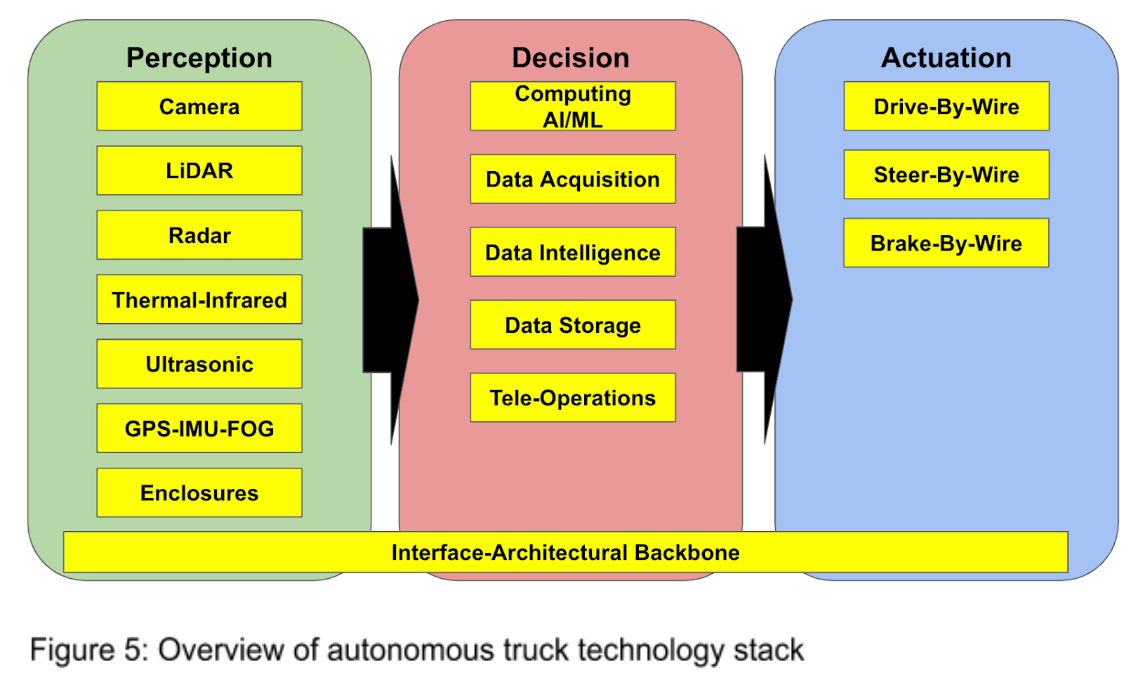
"Geofencing and Operational Design Domain (ODD) will be necessary in the short and medium term for AV trucking. The ones (companies) that have clearly defined operational design domains are the ones that will move faster." — Leading AV technology supplier
Given the extensive technological hurdles that still need to be overcome, self-driving trucks will (and have been) initially deployed in selected environments based on certain criteria: weather, speed, roads, etc. Once the vehicle's use case has been proven in a given ODD, then the ODD can be expanded.
Despite these hurdles, there are many players who believe that they have the right strategy to bring this innovation to market.
The self-driving technology landscape will broadly be composed of two types of players: the technology providers and the truck manufacturers (OEMs).
Market Landscape for the New Self-Driving Trucks — Who will bring the technology to market?

Technology Providers:
The technology providers are aiming to provide the "driving" technology for the truck to move from one location to another; as such they are primarily software driven instead of hardware driven. Their technology helps the vehicle understand their surrounding environment to make driving decisions. As newer players, these companies are able to attract top engineering talent and have access to high levels of capital — well over $1.2B for the companies listed above. However, as significant amounts of capital have been invested in these companies, the industry is finding that it's far more difficult to overcome a variety of hurdles across technology and regulation.
Technology providers will need to focus on specific use cases in the trucking space in order to deliver and capture value in the short term. This may become particularly critical in an economic environment post Uber/WeWork IPOs where investors are more conservative with their investing decisions. Companies will need to manage their cash as they experiment to find commercialization.
Truck OEMs:
The truck manufacturing industry for Class 8 trucks is largely dominated by four major players: Daimler (Freightliner, Western Star), PACCAR (Kenworth, Peterbilt), International (Navistar), and Volvo (Mack). Despite these companies' public remarks of support, we can assume that they see automated technology as an existential threat to their existing businesses because of new players and higher truck utilization. This is particularly the case when it comes to recruiting top talent with compensation packages that don't provide the same level of upside as those provided by the technology providers. Nevertheless, by running an internet search of an OEM's name and "self-driving", you will find articles highlighting the companies' direction towards an automated future (Daimler, Volvo, Paccar, Navistar). These companies are moving forward in developing technology that ranges from SAE Level 2 driver assist to full Level 4 capabilities (see Appendix 2 for description of SAE Levels). These firms are betting (and maybe hoping) that the time to develop Level 4 capabilities will continue to be prolonged. With an existing business that provides sustainable levels of cash flow, the OEMs would be well positioned to outlast the technology providers as self driving technology navigates the various stages of the "hype cycle."
Despite the recent news surrounding the OEM's desire to develop SAE Level 4 capabilities in-house, some industry experts believe that OEMs may be more inclined to outsource the R&D development to the technology providers. One investor from a leading venture capital firm expressed that OEMs would need to be careful developing L4 capabilities in house as it may be perceived as a direct threat to fleet operators who are their existing customers.
Market Landscape for the New Self-Driving Trucks — Who are the customers?
"AV Trucking [providers] will need to get the fleet owner to say yes, 'I am going to buy or lease'…I expect hybrid models and anticipate the biggest challenge to be associated with who handles liability." — Trucking industry expert
We take into account the view of the customer purchasing self-driving capabilities when analyzing target customers. From reviewing the value chain in Figure 2, we see that potential customers for self driving trucks will be
- Fleet Operators (Carriers)
- Shippers
We believe that the target customer for self-driving trucks will be fleet operators. Additionally, 3 out of 4 industry experts we interviewed expressed that carriers will be the target customers for self driving trucking companies. Increased utilization, improved fuel economies, and lower rates of accidents were the categories that interviewees expressed would see the largest carrier benefit of automated technology.
The contrarian view to carriers being the optimal customer for automated trucking was an investor who claims that technology providers will eventually turn into fleet operators themselves in order to manage service-level agreement (SLA) requirements associated with faster deliveries. As such, the technology providers may find shippers (e.g., Target, Walmart) as the target customer and sell directly to them. This may pose non-market challenges (e.g., regulatory implications, public pushback) as the carriers get pushed out of the value chain.
Market Landscape for the New Self-Driving Trucks — Regulatory Challenges?
At the federal level, the rollout of Automated Technology will be regulated by the Department of Transportation (DOT), National Highway Traffic Safety Administration (NHTSA), the Federal Motor Carrier Safety Administration (FMCSA), the Senate Committee on Commerce, Science, and Transportation among others. Across the board, the federal body sees this technology as a way to save lives and improve the competitive advantage of the United States. This can be further illustrated by NHSTA's stance on automation as an opportunity to improve safety while the FMCSA is reaching out to the public for feedback on pushing regulation forward.
The DOT has expressed its support for automated vehicles with it's public document, "Preparing for the Future of Transportation." In the document, the DoT illustrates its guiding principles towards an automated future (Appendix 3).
These principles illustrate to us that the federal government is prioritizing safety, reduced regulatory hurdles, and respect for the everyday individual's choice to mobility. These priorities are important for the trucking industry as:
- Long-haul trucking would previously have to encounter inconsistent regulations across different states. A federal standard, as deemed pursued by the FMCSA, would help remove uncertainty.
- The truck drivers, who are already hindered in their ability to unionize (per the diminished state of unions such as Teamsters), will face an uphill battle without support from the federal government to prolong automated technology. That is unless it can be shown to bring risk to the DoT's objective around safety.
Despite the support for this technology among influential groups, there is always risk of potential resistance from existing unions and government officials such as Senator Blumenthal who expressed that "rules are as important as the technology." This is understandable given past scandals across the automotive and technology industry (e.g., Volkswagen emissions scandal and data privacy in Big Tech) where regulators have grown skeptical of leaving it to corporations to regulate themselves.
"For any segment of the trucking industry, I can guarantee you that the established players will have significant input into regulation…Incumbents have a leg up because regulators will ask them for input first" — Keith Hennessey, Stanford GSB Lecturer and Former Economic Advisor to President George W Bush
Speaking with Hennessy, we understand that stakeholders who are resistant to changes in transportation may mobilize in the form of an "Iron Triangle."
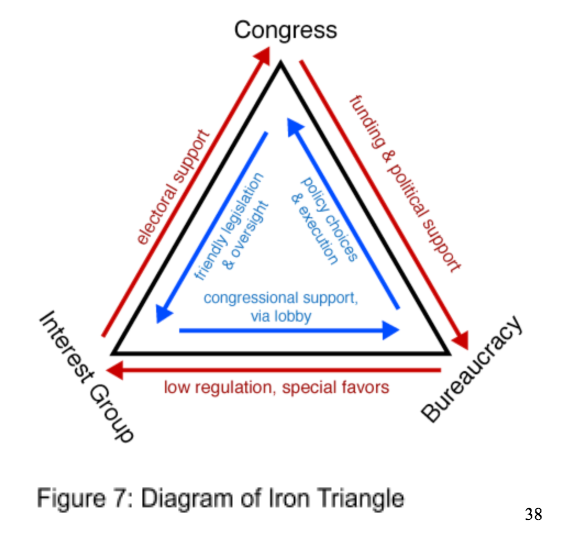
Per Hennessey's observations the three corners would be composed of
- Interest Groups: Teamsters, Big Trucking Companies, Manufacturers
- Congress
- Bureaucracy: Department of Transportation or Federal Motor Carrier Safety Administration; Executive Branch and Regulators
These corners form a very strong coalition that heavily favors the incumbents despite any market inefficiencies that may be caused. Although we believe the risk for the Iron Triangle in trucking is minimal given the influence of the Teamsters and support from Bureaucratic bodies, this is something that companies looking to commercialize self-driving technology in the trucking space should be aware of. If it can be proven that automated trucks are not as safe (given cybersecurity and technology malfunctions) or if there is greater than expected job loss, then the viewpoints of various stakeholders can change dramatically.
Trucking Economics:
The American Trucking Association has determined that the average incremental cost per mile is around $1.82. Automation technology will have the largest impact on driver wages and fuel costs. Insurance will be an affected cost category, but several experts we interviewed believe that the impact on the cost of premiums will be negligible given the low current cost of the category and slight expected fluctuations across the short and long term. Maintenance is another category that will be impacted by automation. Automation will reduce accidents and unplanned maintenance in the long-term; however, increased part utilization and added sensor parts requiring new forms of planned maintenance will most likely offset any improvements gained from reductions in unplanned maintenance activities. For these reasons, the main focus of our analysis will be on the effect of automation on fuel costs and driver wages which accounted for 66% of a truck's Average Marginal Cost per the table below. It is worth noting that the driver-based costs have driven the 17% growth in unit costs for trucks from the 2010 to 2018 year period. This further highlights the growing need for solutions that can mitigate this cost center in a responsible manner.

Economics of Shipping Tomorrow:
In order to understand the feasibility of autonomous vehicle technology, we need to compare the cost of the AV technology vs. the cost savings. We interviewed multiple suppliers in the AV space to determine the cost of AV parts (short and long term) and technology (e.g., software, interfaces). Given that there is no clear timetable for when the technology will be deployable, we identify time horizons by level of scale in number of units rather than time. As such, we define short term and long term as the following.
Short Term (ST): Early commercial deployment with fleet size in the tens of units
Long Term (LT): Large scale deployment with fleet size in the thousand units
After identifying short and long term AV costs, we used interview data to determine an updated lifespan for a truck given utilization increases. From speaking with a trucking company, we believe that the useful life of trucks is five years for national carriers despite the practice of running a truck for 15 years. As such, for this analysis we will assume a five year useful life. From that discussion, we estimate utilization increases to bring the lifespan of an automated truck down to three years. We are not assuming meaningful improvements in the durability of trucks. From this assumption, 2.75 years is the time used to amortize AV capex costs as well as provide the foundation to update the accepted industry vehicle miles traveled (VMT) per truck per year from 91,506 to 166,375. As summarized in the table below:

To evaluate the impact of software development to the unit of economics, we assumed fleet sizes of 50 and 1,000 in the short term and long term. After speaking with two industry professionals, we've estimated the software and algorithm development costs to be $10,000,000. This estimation is based on the expected costs of an engineering team to integrate an open-source AV software into a company's vehicle platform.

We determined the total short-term AV cost per year (amortized CAPEX plus OPEX) to be $154,858 and the long-term AV cost per year to be $15,300. By dividing the short and long term yearly AV costs by the 166,375 yearly miles each truck is estimated to travel, we arrive at a short-term AV cost per VMT of $0.93 and a long-term AV cost per VMT of $0.09.
Therefore, for an AV trucking strategy to be successful, it must contribute savings of $0.09 per VMT in the long-term.
Please see Figure 11 for a detailed breakdown of the cost analysis.
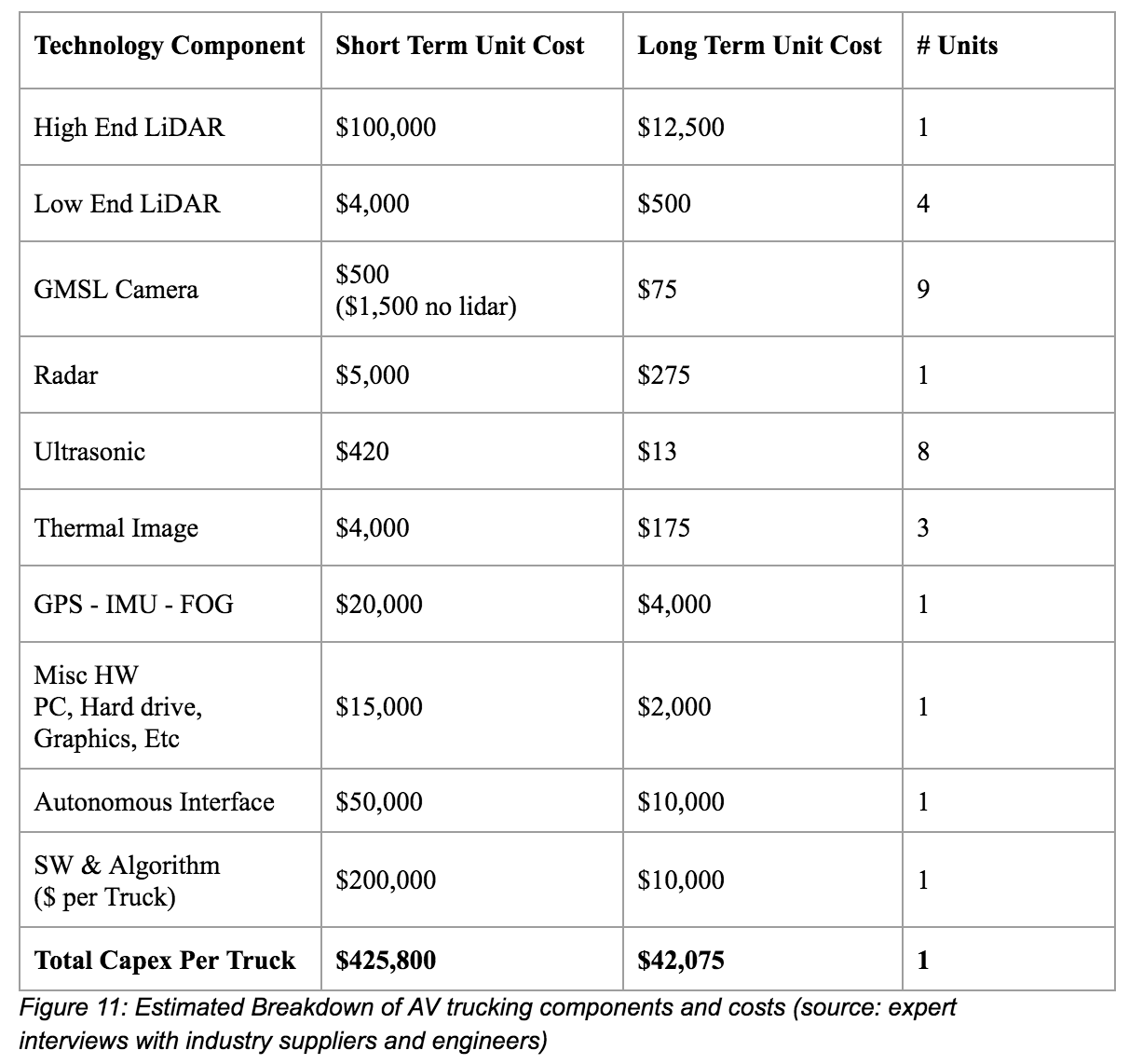
Detailed descriptions of terms can be found in Appendix 1
Go To Market Strategies for tomorrow's players
Through our discussions, we've identified three possible go-to-market strategies that AV trucking vendors can pursue. To understand which strategy is best positioned for long-term success, we will evaluate the following three criteria:
- Unit of Economics
- Technological Feasibility
- Non-Market Risks
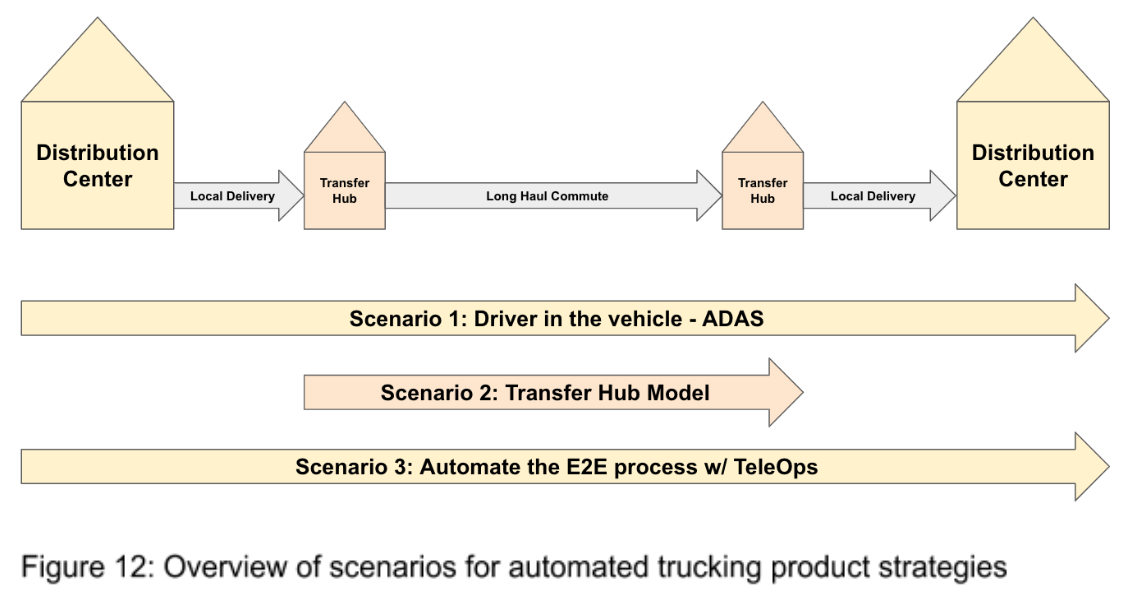
Scenario 1: Driver in the vehicle — ADAS
Here we anticipate the driver to be in the truck during the entire route from the Distribution Center to the Distribution Center while the self-driving technology is leveraged as an advanced driver assist system, or ADAS. In this scenario, ADAS will be able to automate portions of the trip, but not to the point where it is trust to remove the driver from the vehicle. Additionally, the driver will need to maintain engagement with the task of driving (despite not controlling the wheel for periods of time) during the time of the trip for the instances when ADAS needs the driver to take over.
Scenario 2: Transfer Hub Model
In this scenario, self-driving technology will be leveraged for long haul commutes in the open freeway where the automated truck will only need to "operate in the simplest and most structured environment." Cargo will leave a distribution center or factory in a manned truck before arriving to a "transfer hub." In the transfer hub, the cargo will move to an unmanned truck with self driving technology. The autonomous truck will traverse to a distant transfer hub where the cargo will be moved to a manned truck for the final portion of the trek to a nearby distribution center. The goal of the transit hub is to limit the complexity of a fleet's operational design domain (ODD). Therefore, potential transfer hubs should limit any turns or complex maneuvers a truck will have to make. Highway truck stops and trains that can enter production facilities (see figure below) are good visualization examples of how a transfer hub model would be structured near a highway.
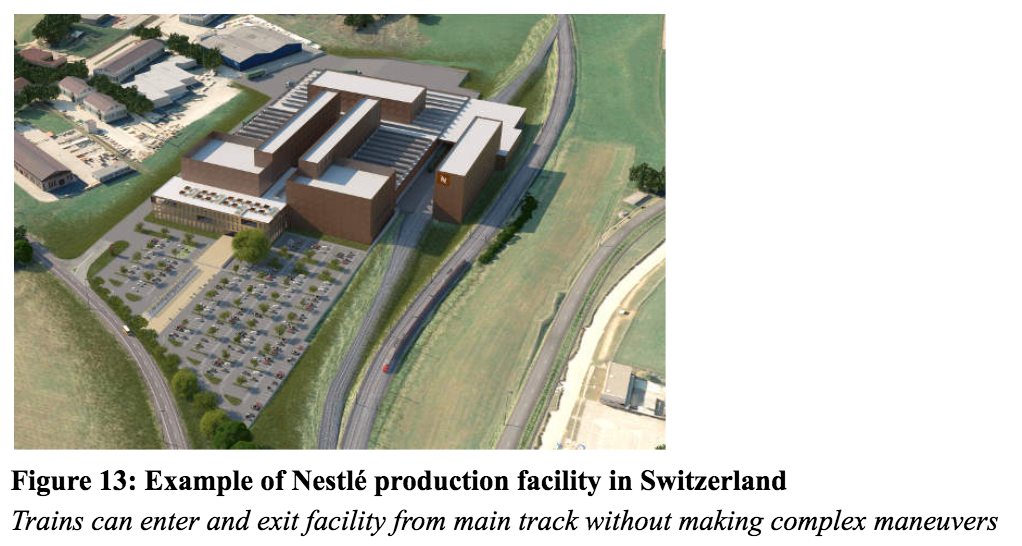
Figure 13: Example of Nestlé production facility in Switzerland
Trains can enter and exit facility from main track without making complex maneuvers
Scenario 3: Automate the end-to-end (E2E) process w/ TeleOps
In this process, the truck will be "fully automated" from distribution center or factory to another distribution center without having to leverage transfer hubs. For instances where the truck encounters a niche case and cannot proceed, the truck will be directed by an operator via the teleoperations model and subsequently continue on its route.
Unit of Economics Overview
In summary we analyzed the unit of economics for each scenario by analyzing the change in capex (per incremental AV technology costs), fuel costs, insurance premiums, and driver costs. We can summarize our assumptions below

Scenario 1: Driver in the vehicle — ADAS
By keeping the driver in the vehicle, the ability to offset AV technology costs with cost savings is limited. An expert in the field of trucking energy management estimated that automation will provide anywhere from a 5–20% improvement in fuel efficiency depending on the ODD. Our analysis chose 10% as a conservative estimate given the opportunity for fuel efficiency is higher on highway miles. There is a case that ADAS technology will improve driver safety and reduce insurance premiums; however, given insurance only makes up $0.04 — $0.05 of cost per VMT, any slight impact will be negligible on total cost per VMT. In Scenario 1, we estimated automation to bring a total benefit of $0.05 per VMT between fuel savings and a slight (10%) reduction in insurance premiums.
The new total cost per VMT for this scenario is $2.70 in the short-term and $1.86 in the long-term.
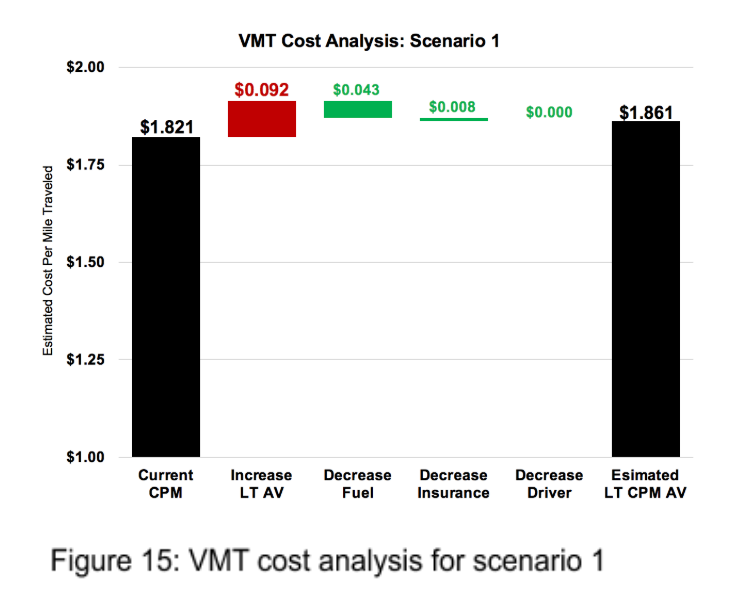
Scenario 2: Transfer Hub Model
Unit of Economics: Determining the unit of economics for a transfer hub model can be complicated because players chasing this strategy treat key assumptions such as the distance between transfer hubs and final destinations as intellectual property. This is important because the ratio between total route distance and the distance from transfer hubs to distribution centers determine the percentage of route miles that will be impacted from automation. For example, if an entire trucking route is 500 miles, and the distance between transfer hubs and distribution centers is 100 miles, then 400 miles will be automated and see cost savings from automation technology. We created a matrix to identify potential ratios between route distance and transfer hub distances.

From there, we multiplied that ratio by taking the weighted average of the cost per mile for miles driven by a driver vs cost per mile for miles driven by an automation. We assumed that a teleoperations or remote assistance professional will be managing 30 trucks at a time hence why there is still a driver cost with automation. Additionally, we assume that the cost of reattaching trailers to different tractors for final delivery is minimal.

To identify the most appropriate cumulative distance between transfer hubs and distribution centers, we looked at anecdotal evidence from Google Maps for a trucking route from Los Angeles to Houston. We selected a location near Los Angeles and Houston where we thought it would make sense to have a transfer hub (below). The site selection was based on proximity to the respective city center without being in an area that is relatively dense or has geographic variation.

After selecting the hypothetical location, we calculated the average distance between that location and distribution centers for the respective city. To calculate the average distance, we selected the distribution centers that were in the approximately most western, northern, southern, and eastern locations of the city center. After obtaining the four distances for each city, we calculated the average distance between the transfer hub and distribution center for both cities. Our analysis showed that the average distance between a transfer hub located outside a major market and distribution centers in a market is 100 miles.
For this reason, we selected the average driver cost per mile for the 200 mile column (Figure 17) which gave us an average driver cost per mile of $0.160, or a net reduction of 79% for driver costs.
We calculated the fuel savings of 8.2% by multiplying 10% fuel savings by the average percent of miles being automated (82.1%) when the distance to transfer hubs is 200 miles.
For insurance premiums, we assumed a more conservative estimate of 5% reduction given that there isn't much certainty around how insurance companies will treat self-driving technology.
By automating 82% of a route's miles through the transfer hub model, expected savings are $0.56 per VMT from a major reduction in driver costs and a slight increase in fuel efficiency. The new total cost per VMT for this scenario is $2.10 in the short-term and $1.26 in the long-term.
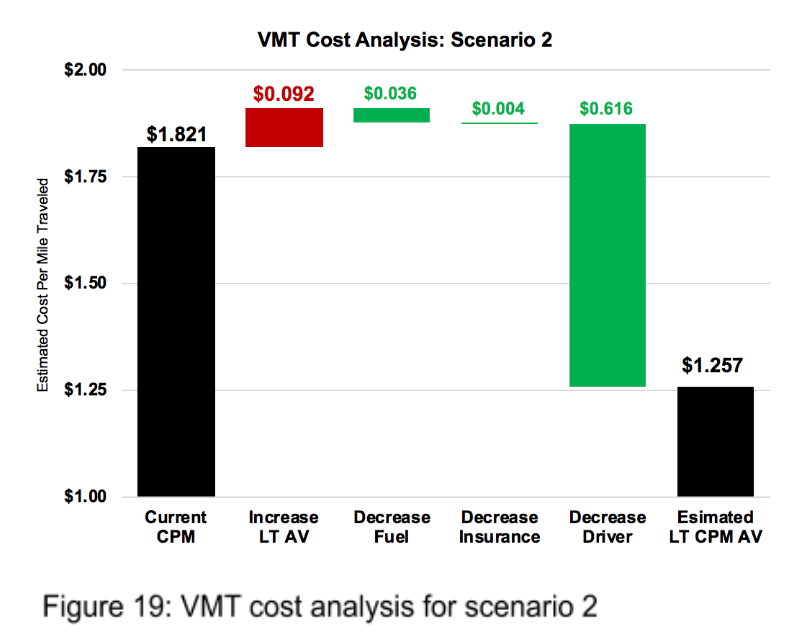
Scenario 3: Automate the E2E process w/ TeleOps
Scenario 3 provides the strongest case from a unit of economics perspective.
Even with full end-to-end automation, some human oversight is still required for autonomous vehicles. An autonomous truck enters a new ODD when it leaves the highway and travels in an urban environment. The truck will encounter unordinary actions from pedestrians, construction zones, and many more unique obstacles that will need human intervention through teleoperations. There will be some domain complexity seen on highways (e.g., construction zones), but autonomous trucks will have an easier time navigating these circumstances on highways compared to urban districts. As previously mentioned, we will assume one teleoperator can oversee a fleet of 30 trucks. With this ratio in mind, we can assume that Scenario 3 automation will reduce driver costs by 96.7%. Combined with a slight increase in fuel efficiency, estimated cost benefits per VMT from automation in the long term will be $0.70. We assumed that there will be no change in insurance premiums given that automated local delivery is very challenging, and it would be difficult to determine how insurance companies will take that into account.
The new total cost per VMT for this scenario is $1.96 in the short-term and $1.12 in the long-term.
Scenario 3 would drive the greatest economic benefit with an expected savings per mile traveled of $0.701–24% greater savings than what is calculated in Scenario 2.
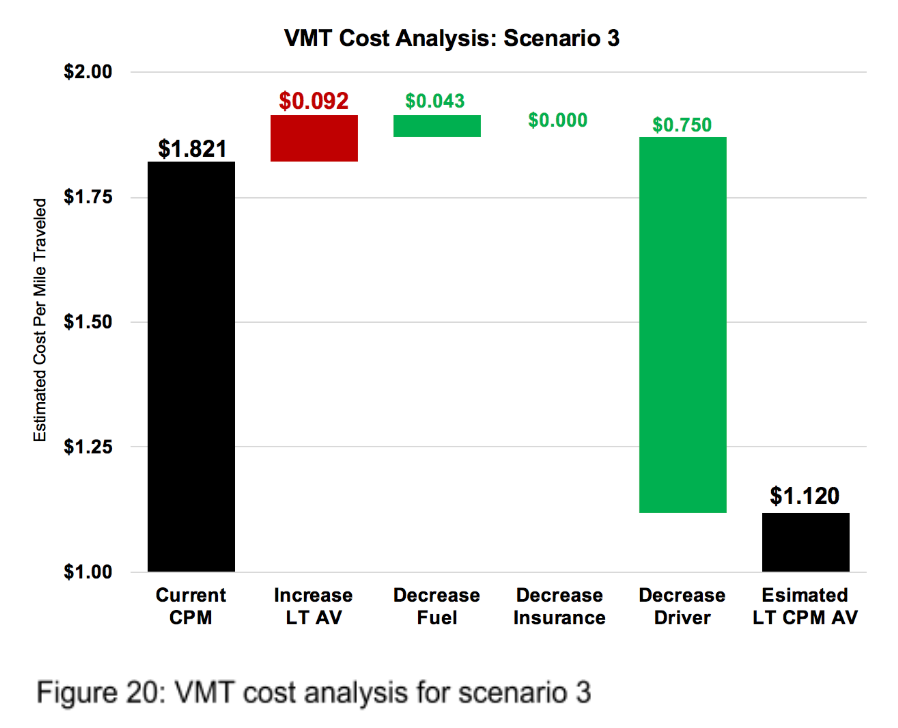
In summary:
From a unit of economics perspective, Scenario 2 and 3 are the two situations where we see financial benefits towards commercializing self driving technology in the trucking industry. We will now look to share our qualitative findings from a technological and non-market evaluation.

Technological Feasibility
Scenario 1: Driver in the vehicle — ADAS
From a technological feasibility perspective, this scenario would not deviate much from the current status quo as some trucks are already benefiting from automated technology that perform driver assist functions. One company that demonstrates this is Plus.AI who is leveraging its automation technology for Level 2 applications such as fuel efficiency, safety, and routing while a human driver is behind the wheel. Although the operating cost does not reduce significantly, it's worth noting that the average cost of an accident is approximately $148 thousand — a figure that balloons to $7.6M when there is a fatality. We did not incorporate these numbers into the unit of economics as we assume insurance costs take into account much of these costs and we are unable to determine the capability required to capture this value.
Scenario 2: Transfer Hub Model
"I expect the first application of self-driving technology to be in interstate highways because it's so predictable…it's a much cleaner environment." — Leading supplier for self-driving trucks
Our discussions lead us to believe that performing L4 technology in certain operational design domains would enable faster short go-to-market time horizons for trucks than ridesharing. This is largely due to attributes of interstate highways in the southeastern part of the USA having limited turns, better weather, etc. It has been reported that autonomous trucking company Embark states it can perform a route without a safety driver behind the wheel. Nevertheless, the feasibility of this application remains to be seen as Starksy Robotics appears to be the only self-driving trucking company that has performed a route without a safety driver whereas competing firms still include a test driver (i.e. Embark, Kodiak, and Ike).
Scenario 3: Automate the E2E process w/ TeleOps
"What's not well understood are the challenges associated with navigating city streets. If you take a right hand turn you might as well be solving the robotaxi problem." — Professional from the technology industry
As Starsky Robotics crossed the milestone of completing a nine mile self-driving trip without a safety driver, it remains to be seen if this technology will be able to scale given challenges associated with navigating the last mile. This portion of the route is clearly more challenging than the long haul commute. Additionally, it is unclear if the assumptions associated with teleoperations and remote assistance capabilities will hold true as the service scales. Finally, trucking professionals across the industry express the value that truck drivers provide when commuting off the highway such as relationship management, loading/unloading, security, maneuvering in changing conditions, etc. These behind the scenes "jobs" would be very challenging to replace by technology.
If the technology gets to the point where trucks can provide completely autonomous transportation of goods from end to end, then there will be potential social backlash risk. Michael Ostrovsky, a Stanford Economics Professor who has done research on self-driving technology, highlighted that this technology will scale quickly once it becomes available. As such, many people may find themselves out of a job. This may influence drivers to organize and protest by highlighting potential security risks associated with self-driving trucks. During the hearing with the Commerce, Science and Transportation Committee, Ken Hall of the International Brotherhood of Teamsters highlighted risks with self-driving trucks associated with data privacy and cyber security (as it relates to trucks used for terrorist attacks). With their livelihoods threatened, truck drivers may be more inclined to push on these points to delay the roll out of technology that takes away their jobs.
In summary:
We see that Scenario 1 has the highest feasibility. The Transfer Hub model has a medium to high level of feasibility given that companies are already deploying self-driving trucks on highways and have demonstrated to be near the technological feasibility to fully do so. We gave Scenario 3 a lower score because we are seeing challenges in the industry to automate driving in urban environments, and we believe that trucks will face greater challenges given their sizes (even with effective teleoperations and remote assistance capabilities).
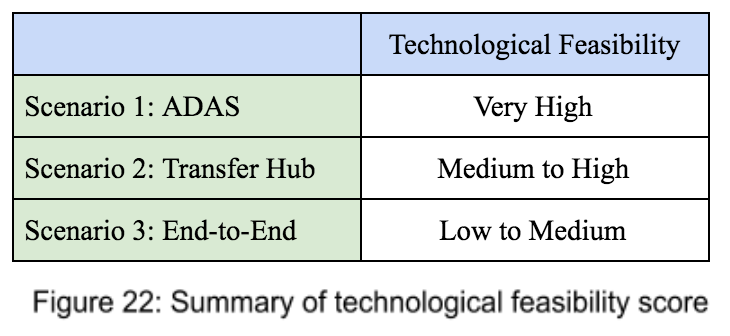
Non-Market Forces (e.g., regulation, PR pushback, unions, labor strikes)
Scenario 1: Driver in the vehicle — ADAS
For non-market factors, we don't believe there is any risk here given that drivers will not be displaced to any extent.
Scenario 2: Transfer Hub Model
Although successful automation of long haul trucking would result in a reduction of jobs, we do not believe that this will result in potential backlash given that this would mainly impact drivers in strenuous, long haul routes. The US trucker shortage is expected to double over the next decade (already 60,800 in 2018). This is largely due to the fact that long haul trucking is a really hard job with poor working leading to higher rates of obesity, diabetes, anxiety, depression, cardiovascular disease, divorce, and drug abuse than the average Americans. By automating the long haul route, truck drivers can focus more on local delivery which we believe provides a better quality of life.
Scenario 3: Automate the E2E process w/ TeleOps
"Not easy for truck drivers to organize and push back… I think they're screwed if a segment of the industry decides to automate. The drivers are screwed" — Local delivery owner and former truck driver.
Despite the risk of social backlash, we still think the risk is minimal given the fact that truck drivers do not currently have an effective way to mobilize as highlighted by the previous quote. This was further illustrated during a recent attempt by truck drivers to rally in the "Black Smoke Matters" protest. The truck drivers wanted the FMCSA to take their side into account when implementing new policies — particularly for the electronic-logging-device mandate. The protests weren't as successful as expected as only 78 drivers participated in cases where there was a forecast of 400–500 in Indiana. These experiences have led us to believe that drivers will not see success in lobbying against self-driving trucks in the face of widespread job automation.
In summary:
We see that there is minimal risk of non-market backlash across the board. We see technology in Scenario 1 and 2 as being a tool for augmenting driver capabilities or filling a need for drivers in long haul trucking (given a driver shortage). However, Scenario 3 has the potential for severe harm given the potential to displace the vast majority of truck drivers.
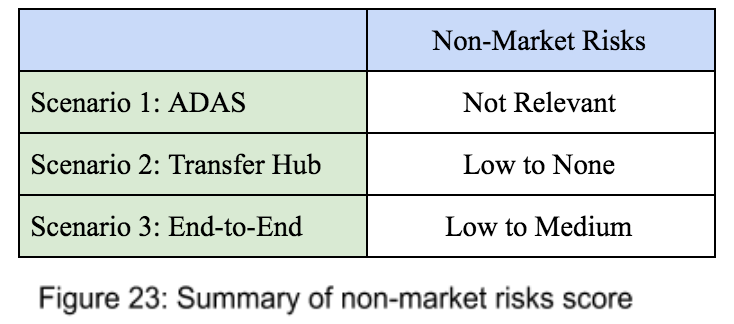
Conclusion
We have concluded that Scenario 2 — the Transfer Hub model — is best suited for success in the long-term. It has a strong business case, while maintaining a reasonable level of technological feasibility and limited exposure to non-market risks. Using full automation technology while leaving the driver in the truck, does not make economical sense in the short- or long-term. CAPEX-light ADAS systems have a place in the trucking world today as long as their costs are offset by efficiencies in fuel and safety. Although Scenario 3 has a strong business case, its ODD is too complex to expect meaningful deployment anytime soon. As soon as players try to automate trucks in urban environments, they concede their advantage of applying automation to a simple ODD.
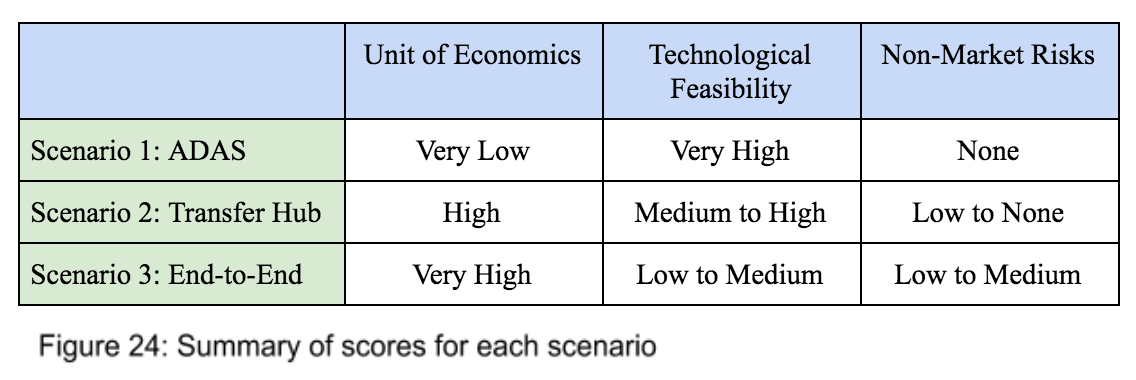
In our cost analysis, a major assumption still undefined is when short- and long-term costs will align with the expected savings from automation technology. We assert that technological feasibility matters and not the time of achieving economies of scale — at least in the eyes of the market. As soon as technological feasibility is established, public and private investors will reward AV trucking providers and punish those not near technological feasibility. We saw this play out in the transportation industry several years ago. In April 2013, Uber launched UberX — giving almost every car the ability to compete with taxis. Shortly thereafter in August 2013, Uber received Series C funding round of $258M. At this time, driver supply on the Uber platform was still low, but the markets rapidly punished public companies that sold taxi medallions.
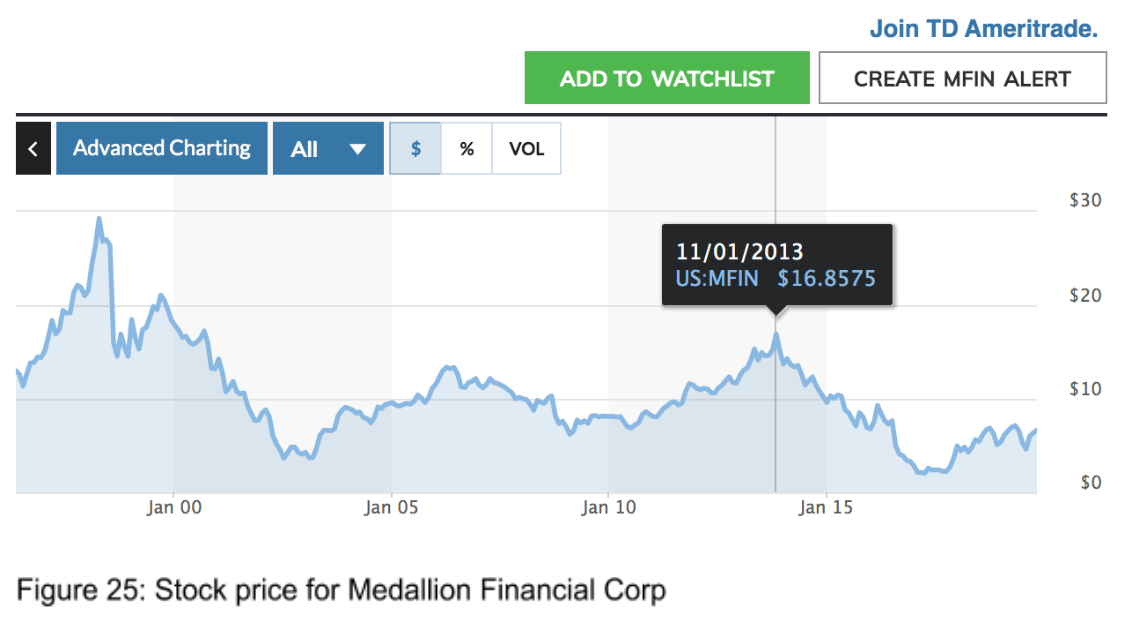
Similarly, once technological feasibility is established with AV trucking (i.e., every truck can become autonomous), the capital markets will penalize carriers which will limit their opportunities for strategic decisions (e.g., acquisitions) with less money coming in. If today's carriers want a seat at tomorrow's table, they need to act now through long-term strategic partnerships and / or investments.
Thank you for taking the time to review this report. We are very excited about the prospects of automated technology in trucking. Please reference Appendix 5 to recognize those that have given their much appreciated time to help us in this effort.
Appendix 1
This section is further explanation for the terms in Figures 5 and 11.
Camera: Arguably the most accurate way to create a visual representation of the world. They are placed on every side of the vehicle to provide a 360 degree view of the environment. Cameras can provide up to a 120 degree visibility, or can provide "fish-eye" for a panoramic view. The limitations involve calculating the distance of objects along with detection in low visibility conditions i.e. sun glare, fog, rain, or nighttime.
Radio Detection and Ranging (Radar): Effective for supplementing camera vision in low visibility. They work by transmitting radio waves in pulses — once the wave hits the object, it is returned to the receiver sensor providing data on speed and location (distance) of the object. They are not very well able to distinguish between different types of objects.
Light Detection and Ranging (LiDAR): More accurate sensor for measuring distance by pulsing lasers to provide a 3D view of the environment. As the lasers bounce off nearby objects (signals) and return to the sensor, signals create "point clouds" representing a vehicle's surrounding environment. The challenge with Lidar, however, involves perceiving objects over long distance and can be stymied by heavy rain or snow.
Ultrasonic sensors: Similar to radar and sonar, ultrasonic sensors evaluate their targets by measuring reflected signals with sound waves. Very effective for detecting objects in close range and slow moving applications such as parking — accuracy can vary with soft materials that can absorb the waves. Ultrasonic sensors also have a limited detection range.
Sensor Fusion: Sensor inputs from the perception tools are fed into a high-performance, centralized computer which fuses relevant portions of the data for the car to make driving decisions.
Thermal (or Infrared) Cameras: These cameras will complement standard cameras during times of low-visibility conditions by detecting wavelengths below the visible spectrum that indicate heat. A demonstration by FLIR shows how these sensors are effective for detecting living objects during nighttime and hot days.
Initial Measurement Unit (IMU): A device that directly measures a vehicle's three linear acceleration components and three rotational rate components to track a vehicles attitude, velocity, and position. The IMU is unique in that it doesn't need a connection to the external world.
Global Positioning System (GPS): Used to locate the vehicle's location in the world.
Fiber Optic Gyro (FOG): A fiber optic gyroscope detects changes in position or direction using the Sagnac effect. The optical gyro operates by using light passing through a coil of optical fiber. Inside a typical optical gyroscope, a spooled-up optical fiber carries pulses of laser light. Some pulses move clockwise and others go counterclockwise. The gyro measures rotation by detecting tiny changes in how these pulses arrive at a sensor.
Enclosures: Cases to protect sensing technology from the outside environment.
Compute: The electronic devices for storing and processing data in applications such as data collection and retrieval, algorithm development and processing, and deep learning.
Data Acquisition: High-bandwidth interfaces and storage hardware used for gathering and retrieving large amounts of data.
Data Intelligence: Hardware and software that leverages acquired data to increase security, lower cost, and improve performance / efficiency of the automated truck.
Data Storage: Storage systems designed for the massive amounts of data generated by autonomous vehicles.
Tele-operations: The ability to remotely drive or command a vehicle from afar via cellular or mobile communication technology. One variation of this is remote assist where the controller guides the vehicle to navigate around an obstacle, but the vehicle is still given the autonomy to move itself.
Interface: Devices that connect the sensor suite from Perception to Decision to Actuation.
Drive-By-Wire: Use electronic control systems using electromechanical actuators and human-machine interfaces such as pedal and steering feel emulators to replace traditional mechanical and hydraulic control systems. An actuator consists of three main parts, the motor that moves the actuator, the clutch that allows the actuator to be disengaged, and a position/extension sensor.
Steer-By-Wire: Enables safe and reliable vehicle steering by purely electronic means, thereby eliminating the need for a steering wheel, steering column and associated mechanical linkages.This is performed by leveraging components such as an Electronic Power-Assisted Steering System (EPAS) Motor. An EPAS Replace the existing steering column with an electric motor and torque sensor that is fitted with the steering column.
Brake-By-Wire: Ability to control brakes through electrical means. A car equipped with brake by wire technology has a small electric motor near the wheels that generate the braking pressure. They are governed by electronic control units connected to the brake pedal that receive input from the driver's actions and interpret that information into a series of electronic instructions. These instructions are then communicated through a miniature, real-time network connecting the entire braking system.
Appendix 2
This section is used as a guide for SAE automation levels referenced throughout the paper.
Appendix 3
This section lists out the U.S. DOT Automation Principles.
- We will provide safety
- We will remain technology neutral
- We will modernize regulations
- We will encourage a consistent regulatory and operational environment
- We will prepare proactively for automation
- We will protect and enhance the freedoms enjoyed by Americans
Appendix 4
Increase in Long Term (LT) Autonomous Vehicle (AV) Costs
Same methodology for Scenario 1, 2, and 3
(Total LT Capex AV Truck Components) / (AV Truck Useful Life)) = Total LT AV Cost Per Year
Total LT AV Cost Per Year / Annual Miles Traveled Per AV Truck = Incremental LT AV Cost per VMT
Incremental LT AV Cost per VMT / 2018 Truck Cost Per VMT = % Increase in LT AV Cost
Reduction in Fuel Costs
Scenario 1: 10% Reduction * Existing Fuel Cost Per VMT = Reduction in Fuel Costs
Scenario 2:
Assume 200 miles total between transfer hub and distribution centers
Assume average % miles automated is 82%
10% Reduction * Avg Percent Miles Automated
Scenario 3: 10% Reduction * Existing Fuel Cost Per VMT = Reduction in Fuel Costs
Reduction in Insurance Premiums
Scenario 1: 10% reduction
Scenario 2: 5% reduction
Scenario 3: 0% reduction
Reduction in Driver Costs
Scenario 1: 0%
Scenario 2:
Avg New Driver Cost = (% Mile Automated * Cost of Teleops) + (% Miles Not Automated * 2018 Driver Cost)
Assume average % miles automated is 82%
2018 Driver Cost = $0.776
Cost of Teleops = 1 / 30 * 2018 Driver Cost = $0.026
1 — (Avg New Driver Cost / 2018 Driver Cost) = Reduction in Driver Costs
Scenario 3: 0% reduction
2018 Driver Cost = $0.776
Cost of Teleops = 1 / 30 * 2018 Driver Cost = $0.026
1 — (Avg New Driver Cost / 2018 Driver Cost) = Reduction in Driver Costs
Appendix 5
We would like to thank the following people for their contributions to this effort
- Professional from a Technology Supplier
- Annie Kadavy, Redpoint Ventures & former Uber Freight
- Professional from an Infrastructure Company
- Professional from the Transportation Management Space
- Professional from a Technology Supplier
- Trucking Operator and Investor
- Professional from an OEM
- Professional from a Technology Company
- Professional focusing on Transportation Policy
- Professional from a Technology Company
- Katherine Casey, Associate Professor of Political Economy at Stanford University
- Keith Hennessey, Lecturer in Economics at Stanford Graduate School of Business and Former Economic Advisor to President George W Bush
- Truck Carrier Operator
- Michael Ostrovsky, Fred H. Merrill Professor of Economics at the Stanford Graduate School of Business
- Professional from a Technology Company
- Professional from a Technology Company
- Technology Investor
- Head of Transportation for an Agriculture Company
- Sven Bieker, Lecturer at Stanford University and Founder of Silicon Valley Mobility
- Transportation Investor
- Professional from a Technology Company
Source: https://medium.com/@michael.wishart1990/a-detailed-commercialization-analysis-of-autonomous-vehicle-technology-in-the-trucking-industry-366fc888cbcc
0 Response to "How Easy is It to Tranfer Self Driving Car Technology to Semi Trucks"
Post a Comment